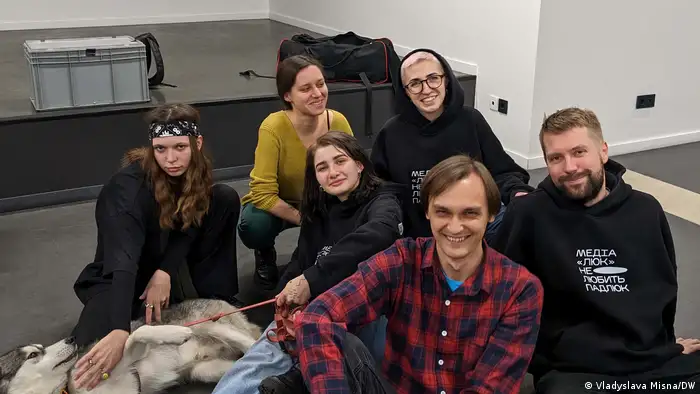DW AKADEMIE
Ukraine: Kharkiv's culture is thriving and Lyuk is there to cover it
Despite the struggles the city continues to face every day, Ukraine's second-largest city remains a cultural hub. With MediaFit's help, the online magazine Lyuk provides a glimpse into the city's underground scenes.
Just 30 kilometers from the Russian border, Kharkiv is the last major Ukrainian city before reaching Russian-occupied territory. Despite near-constant shelling, the metropolis is much more than an embattled city. To uncover what makes Kharkiv so unique, the online magazine Lyuk explores the city's subcultures that have gone mostly unreported until now.
A group of journalists founded Lyuk eight years ago as an effort to report on the city's nontraditional and marginalized groups. Ukraine's second-largest city, Kharkiv has a vibrant alternative scene. Lyuk's name translates to "manhole," a nod to the city's underground cultures.
"We look at what is beneath the surface and find the stories that we do not normally hear and speak to people who are not normally represented in media," said Lina Pluzhenko, a Lyuk manager.
At 20 years old, she is part of a small staff producing more than 20 articles a month on social media. Each documents the still-flourishing cultural scene within a city under siege.
Cultural life on the front lines
Kharkiv's size and strategic location led to a three-month siege at the beginning of the invasion. The Ukrainian military successfully repelled Russian forces, although shelling remains a fact of life in the city. Despite the situation, cultural life flourishes.
"There are at least nine parties a week in the city," explained Pluzhenko. "Only now, the entrance fee goes to the Ukrainian military."
Even movie theaters have stopped pausing their films for air raid sirens, defying existential dangers just a few kilometers away.
Meanwhile, the new normal has led to the return of cultural divisions that were once obscured by a heightened sense of Ukrainian unity.
"At first, we all came together and had one cause," explained Pluzhenko. "But now people are getting used to the war and the fragments of society are once again coming to the surface."
For Pluzhenko, one of Lyuk's most critical topics is LGBTQ rights. She gave the example of the illegality of same-sex marriage in Ukraine. This means that related civil rights such as hospital visitation and burial rights are barred to partners.
"There is a simple truth that war impacts the most vulnerable groups in society," Pluzhenko said.
A niche and loyal market
Reporting on these marginalized groups also positions Lyuk to reach audiences that other media organizations typically ignore. Initially, the outlet's business plan focused on attracting readers and viewers who would not only be Lyuk's story subjects but also its audience. Yet Pluzhenko and her colleagues soon found this was not the case.
Liana Khachatryan is an organizational and development expert in media. MediaFit paired her with Lyuk's staff to create a strategy that could help them stay financially viable in a complex market.
The first thing Khachatryan and Lyuk team members noticed was that the people interested in Lyuk's stories were older than they imagined. Instead of 18–25-year-olds, readers were between 25 and 40 years old.
This was their starting point in drafting a new business model for the online magazine. Khachatryan has worked for years to streamline media organizations. Yet working with Lyuk was a new challenge.
With such a young team, she realized that, while they were producing high-quality content, Lyuk needed to reflect more on their audience and refine stories to match their interests. Khachatryan worked with the small team to define their audience and to also use data to guide other decisions.
"It is not about transforming them into another news outlet," she explained. "What we spoke about was to get them to understand that their uniqueness was their strength."
The team has been working to increase the number of readers who, while not constituting a large target group, have other advantages.
"A niche market is a loyal market," Khachatryan explained.
They have also broadened their approach to fundraising and secured commercial contracts for design projects.
The team grows
All of these endeavors take resources, and their team has grown accordingly with 15 newly hired freelancers joining seven full-time staff members.
"Participating in MediaFit helped us a lot to make general revisions to what we do, what our strengths are and what we still need to strengthen," said Lyuk editor-in-chief Kateryna Pereverzeva. "We have increased subscribers and readers on the site, along with a qualitative increase regarding how the team works."
As the audience grows and the editorial team matures, Lyuk continues to maintain its unique perspective on their city. They bring to light often-overlooked stories that both support and constructively critique Kharkiv in the hopes of moving the cultural needle toward inclusion. And, with the help of MediaFit, the magazine is determined to continue exploring what lies below the surface of Kharkiv's culture long after the bunkers are empty and Kharkiv is at peace once more.
DW recommends
- Date 26.10.2023
- Author Alex Bodine
- Feedback: Send us your feedback.
- Print Print this page
- Permalink https://p.dw.com/p/4Xp7p
- Date 26.10.2023
- Author Alex Bodine
- Send us your feedback.
- Print Print this page
- Permalink https://p.dw.com/p/4Xp7p



